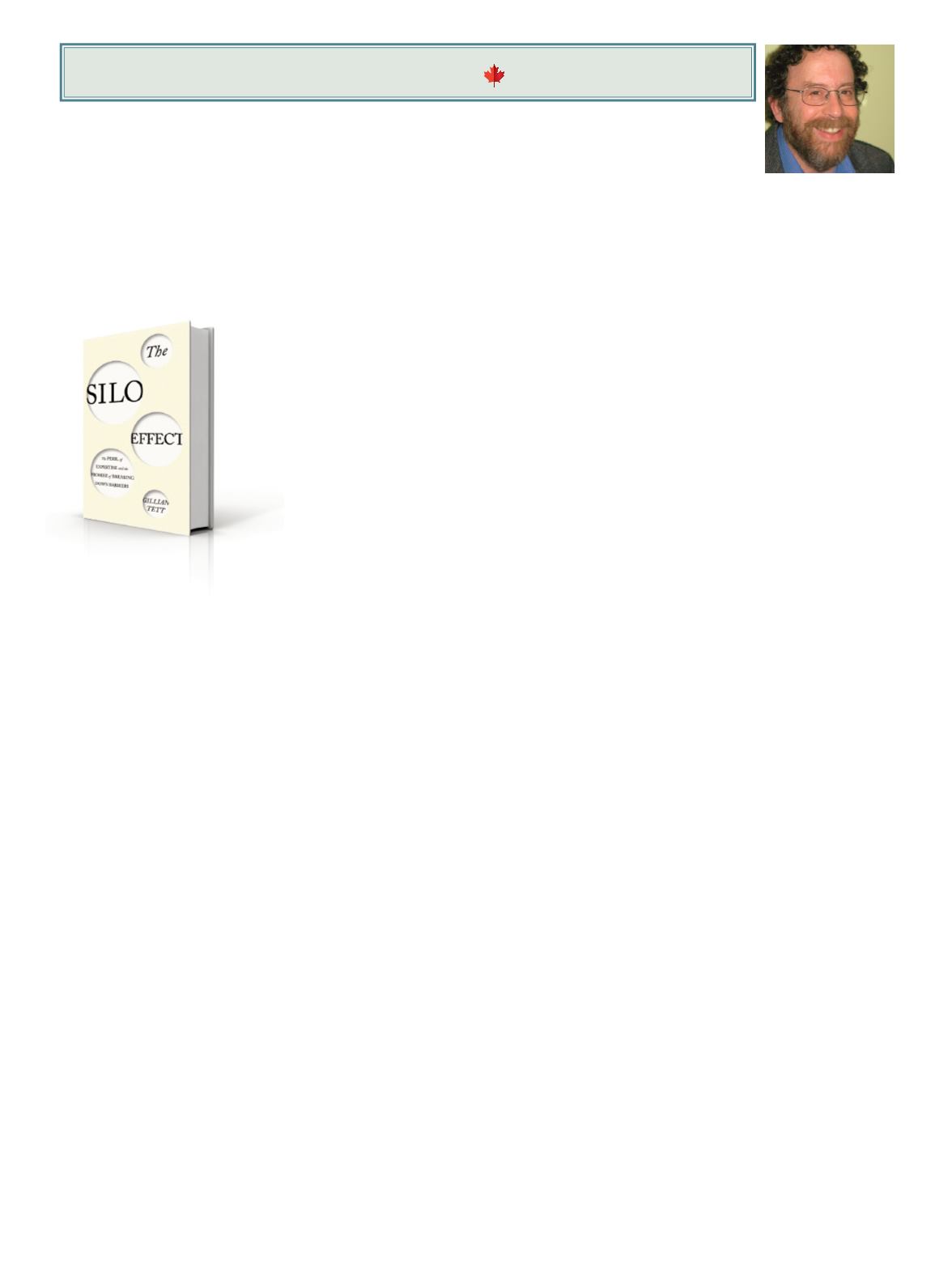

G
overnment is replete with silos. Like
the weather, everyone complains about
them but nobody does much to change
it. And if they try, they often find the si-
los sturdier than expected.
That’s why Gillian Tett’s
The Silo Effect
is an in-
teresting book for government executives. Primar-
ily about business, it still includes government,
which is rare in leadership epistles. And even more
intriguing is that the two prime examples she fo-
cuses on for government are positive stories of silo
busting.
Tett is an acclaimed British financial journalist
who covered the financial crisis and wrote a fasci-
nating account in her 2009 book
Fool’s Gold
. That
book took readers behind the scenes at J.P. Morgan,
where a talented derivatives team came up with a
clever moneymaking idea that was later perverted
into the financial folly we suffered from. As Tett
investigated the crisis, she “saw a world where the
different teams of financial traders at the big banks
did not know what each other was doing, even in-
side the same (supposedly integrated) institution.
I heard how government officials were hamstrung
by the fact that the big regulatory agencies and
central banks were crazily fragmented, not just
in terms of their bureaucratic structures, but also
their worldview. Politicians were no better. Nor
were credit rating agencies, or parts of the media.”
So Tett set out to understand silos, and to look at
how to overcome them. She stresses that silos serve
a purpose. We need to bring together specialists —
in government, academe, and business — to benefit
from their expertise, as they work together. “We
cannot entirely abolish silos, any more than we
could abolish electricity and maintain our modern
lifestyles,” she observes. But when silos become ex-
cessively rigid, entrenched, we can encounter un-
expected risks and lose out on opportunities.
Her introduction begins with a tragic 2011 fire in
New York that claimed three lives and led Mayor
Michael Bloomberg to ask his staff what could be
done to prevent similar events in future. At first
glance, it seemed not much. With only 20 inspec-
tors, the Department of Buildings couldn’t handle
the 20,000 complaints about dangerous housing it
received in a city with one million buildings.
But a member of his team, Mike Flowers, won-
dered what could be done by taking advantage
of the information held by the city’s three dozen
agencies and 150,000 employees. She notes that
communication between these agencies was
patchy at best, to the point on Sept. 11, 2011, after
the collapse of the World Trade Centre, the radi-
os and walkie-talkies used by the fire, police and
health departments could not tune into the same
communication channels. “Nobody had discovered
this before, precisely because these different teams
were so disconnected,” she writes.
Flowers, who had brought together a team of
data crunchers, started to comb through what the
city knew about fire risk. Interestingly, most com-
plaints about illegal conversions emanated from
lower Manhattan, which was not where most fires
— or illegal conversions — actually occurred. Those
happened in the outer boroughs, such as the Bronx
and Queen’s, but the poor immigrant families there
(like the one burned to death in the most recent
fire) were too scared of authorities to complain.
Flowers and his team began to look at data out-
side the obvious departments in many different
databases to see what could be learned about fire
traps. They found four risk factors that, when com-
bined, suggested a dramatically higher incidence
of house fires: Mortgage defaults, violation of build-
ing codes, data on the age of structures, and indica-
tors of neighbourhood poverty. Breaking through
silos to use that disparate data quadrupled the
chances of inspectors turning up a problem.
In Chicago’s Police Department, Brett Goldstein,
a former Internet wunderkind who turned to law
enforcement, set out to reduce the city’s murder
rate by studying gang movement through data in
various departments. Then, like a weatherman,
he issued forecasts that went out to everyone who
could play a role, rather than being restricted by
bureaucratic splits in the force. The murder rate
tumbled to its lowest rate since the 1960s.
Recruited after that to City Hall by new mayor
Rahm Emmanuel, he held a Hackathon — an all-
The Leader’s Bookshelf
Harvey Schachter
The Silo Effect
By Gillian Tett
Simon and
Schuster, 290
pages, $28.00
28
/ Canadian Government Executive
// November 2015














